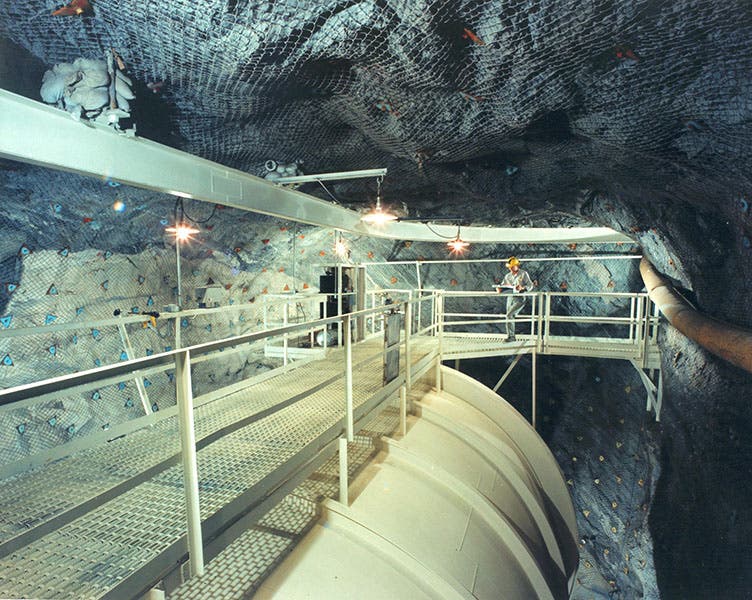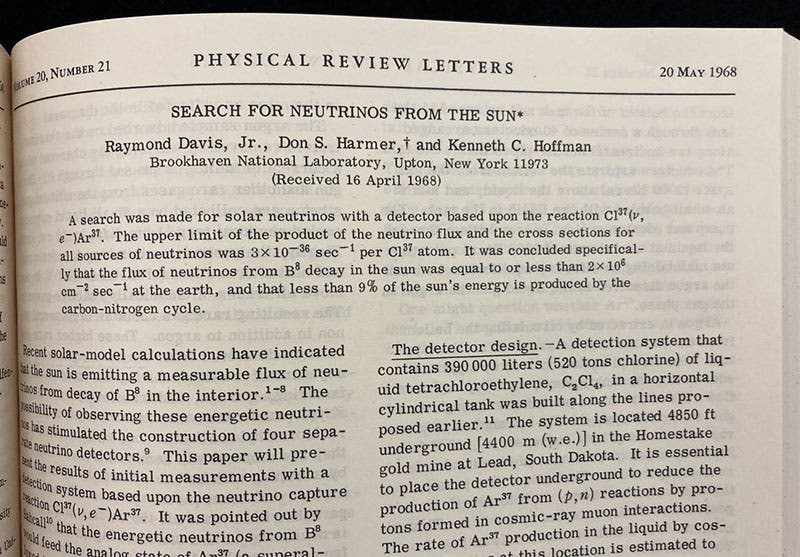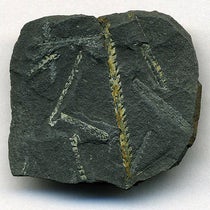Scientist of the Day - Raymond Davis Jr.
Raymond Davis Jr., an American chemist turned physicist, died May 31, 2006, at the age of 91. Davis studied chemistry at the University of Maryland and physical chemistry at Yale, receiving his PhD during the middle of World War II. After three years in the Army, working on chemical weapons, he eventually joined Brookhaven National Laboratory on Long Island, where he found himself looking for neutrinos.
Neutrinos are difficult elementary particles to detect. They have no charge, and practically no mass, so they hardly interact with anything. They were predicted to be a necessary byproduct of beta decay in the 1930s, but were not detected at all until 1956, when Frederick Reines and Clyde Cowan first found them (earning Reines a Nobel Prize in 1995 (Cowan had died by this time) for his efforts).
It had been predicted that the Sun must produce zillions of neutrinos in the process of fusing hydrogen into helium in its core. In particular, it was theorized that a radioactive isotope of boron, boron 8, should be produced, which should immediately decay into helium and produce neutrinos as a byproduct. Detection of some of those neutrinos would confirm (or confute) prevailing ideas about the process of solar fusion. Davis wanted to place chlorine (atomic weight 37) in the path of the neutrinos (called the “neutrino flux”) and test to see if argon 37, a radioactive gas, was produced as a result of a neutrino interaction. A problem was that argon 37 is made in the atmosphere by cosmic rays, so Davis’s solution was to put his argon detector far underground, out of reach of cosmic rays, but not solar neutrinos.
The location he chose was an underground mine in South Dakota, known as the Homestake Mine (second image). Much of the mine was open-pit, but there was a lead mine down below, and a large unused chamber, which is where Davis built a tank for his chlorine, in the form of tetrachlorothylene, C2Cl4 (first and third images). He was ready for the detecting business in 1962. He published his first results in 1968 (fourth image), where he confirmed the detection of argon 37 atoms (and thus solar neutrinos), but also noted that the number found was 1/3 of the number predicted. He continued to count for another 26 years – up until 1994. And always the neutrino count came up short by a factor of 3. The discrepancy between theory and experiment was called the "solar neutrino problem," and no one could explain it. Either the theory – based on the Standard Model – was wrong, or the experiment was not producing correct results. Davis stood by his experimental set up. And he turned out to be right.
One thing no one knew about neutrinos in 1960 was that neutrinos come in 3 "flavors” – there are electron neutrinos, muon neutrinos, and tau neutrinos. Electron neutrinos are the ones produced by the Sun, and the ones that the Homestake experiment was set up to detect. But it was originally thought that, as with any other elementary particle, once an electron neutrino, always an electron neutrino. However, in 1998, it was found that neutrinos, unlike any other particles, could oscillate between their three flavors. So an electron neutrino could arbitrarily become a muon neutrino, or a tau neutrino. If that happened, the new flavors would not interact with the chlorine atoms in the tank. And an observer would detect only 1/3 of the predicted number of neutrinos. Both theory and experiment were vindicated. Four years later, Davis received the Nobel Prize in Physics for 2002. He was 88 years old. He should have received an additional award for stick-to-it-iveness. Thirty-two years is a long time to share your life with an underground tank of dry-cleaning fluid.
I vaguely remember visiting the Homestake Mine in 1969, after Davis's first paper was published, when I was stationed at Ellsworth AFB in Rapid City. South Dakota. I have little memory of the visit, so I must not have been allowed to descend to see the tank, not surprisingly, since it was almost a mile down, and Cold War security prevailed in most places. But a trillion neutrinos probably zipped through my body while I stood there above ground, and perhaps one of them ended up interacting with a chlorine atom down below, and getting counted. It is a cheering thought.
William B. Ashworth, Jr., Consultant for the History of Science, Linda Hall Library and Associate Professor emeritus, Department of History, University of Missouri-Kansas City. Comments or corrections are welcome; please direct to ashworthw@umkc.edu.











